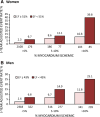Myocardial perfusion imaging in women for the evaluation of stable ischemic heart disease-state-of-the-evidence and clinical recommendations
- PMID: 28585034
- PMCID: PMC5942593
- DOI: 10.1007/s12350-017-0926-8
Myocardial perfusion imaging in women for the evaluation of stable ischemic heart disease-state-of-the-evidence and clinical recommendations
Abstract
This document from the American Society of Nuclear Cardiology represents an updated consensus statement on the evidence base of stress myocardial perfusion imaging (MPI), emphasizing new developments in single-photon emission tomography (SPECT) and positron emission tomography (PET) in the clinical evaluation of women presenting with symptoms of stable ischemic heart disease (SIHD). The clinical evaluation of symptomatic women is challenging due to their varying clinical presentation, clinical risk factor burden, high degree of comorbidity, and increased risk of major ischemic heart disease events. Evidence is substantial that both SPECT and PET MPI effectively risk stratify women with SIHD. The addition of coronary flow reserve (CFR) with PET improves risk detection, including for women with nonobstructive coronary artery disease and coronary microvascular dysfunction. With the advent of PET with computed tomography (CT), multiparametric imaging approaches may enable integration of MPI and CFR with CT visualization of anatomical atherosclerotic plaque to uniquely identify at-risk women. Radiation dose-reduction strategies, including the use of ultra-low-dose protocols involving stress-only imaging, solid-state detector SPECT, and PET, should be uniformly applied whenever possible to all women undergoing MPI. Appropriate candidate selection for stress MPI and for post-MPI indications for guideline-directed medical therapy and/or invasive coronary angiography are discussed in this statement. The critical need for randomized and comparative trial data in female patients is also emphasized.
Keywords: ASNC consensus statement; Stable ischemic heart disease; imaging; women.
Figures











Comment in
-
Sex and gender issues in cardiotoxicity: Are we ready for gynecardiooncology?J Nucl Cardiol. 2019 Jun;26(3):1018. doi: 10.1007/s12350-017-1042-5. Epub 2017 Aug 21. J Nucl Cardiol. 2019. PMID: 28828719 No abstract available.
Similar articles
-
PET-Based Imaging of Ischemic Heart Disease.PET Clin. 2019 Apr;14(2):211-221. doi: 10.1016/j.cpet.2018.12.003. Epub 2019 Feb 1. PET Clin. 2019. PMID: 30826019 Free PMC article. Review.
-
Improved Performance of PET Myocardial Perfusion Imaging Compared to SPECT in the Evaluation of Suspected CAD.Curr Cardiol Rep. 2023 Apr;25(4):281-293. doi: 10.1007/s11886-023-01851-4. Epub 2023 Feb 24. Curr Cardiol Rep. 2023. PMID: 36826689 Review.
-
Relation of Coronary Flow Reserve to Other Findings on Positron Emission Tomography Myocardial Perfusion Imaging and Left Heart Catheterization in Patients With End-stage Renal Disease Being Evaluated for Kidney Transplant.Am J Cardiol. 2017 Dec 1;120(11):1909-1912. doi: 10.1016/j.amjcard.2017.08.006. Epub 2017 Aug 30. Am J Cardiol. 2017. PMID: 28942939
-
Randomized Comparison of Clinical Effectiveness of Pharmacologic SPECT and PET MPI in Symptomatic CAD Patients.JACC Cardiovasc Imaging. 2019 Sep;12(9):1821-1831. doi: 10.1016/j.jcmg.2019.04.020. Epub 2019 Jul 17. JACC Cardiovasc Imaging. 2019. PMID: 31326480 Free PMC article. Clinical Trial.
-
State of the Art in Noninvasive Imaging of Ischemic Heart Disease and Coronary Microvascular Dysfunction in Women: Indications, Performance, and Limitations.Curr Atheroscler Rep. 2020 Oct 3;22(12):73. doi: 10.1007/s11883-020-00894-0. Curr Atheroscler Rep. 2020. PMID: 33009953 Review.
Cited by
-
Coronary Microvascular Dysfunction and Cardiovascular Risk in Obese Patients.J Am Coll Cardiol. 2018 Aug 14;72(7):707-717. doi: 10.1016/j.jacc.2018.05.049. J Am Coll Cardiol. 2018. PMID: 30092946 Free PMC article.
-
Sex Differences in the Coronary System.Adv Exp Med Biol. 2018;1065:257-278. doi: 10.1007/978-3-319-77932-4_17. Adv Exp Med Biol. 2018. PMID: 30051390 Free PMC article. Review.
-
The evolving role of coronary computed tomography in understanding sex differences in coronary atherosclerosis.J Cardiovasc Comput Tomogr. 2022 Mar-Apr;16(2):138-149. doi: 10.1016/j.jcct.2021.09.004. Epub 2021 Oct 8. J Cardiovasc Comput Tomogr. 2022. PMID: 34654676 Free PMC article. Review.
-
Multimodality Imaging in the Detection of Ischemic Heart Disease in Women.J Cardiovasc Dev Dis. 2022 Oct 13;9(10):350. doi: 10.3390/jcdd9100350. J Cardiovasc Dev Dis. 2022. PMID: 36286302 Free PMC article. Review.
-
Stable Ischemic Heart Disease in Women.Curr Treat Options Cardiovasc Med. 2018 Aug 7;20(9):72. doi: 10.1007/s11936-018-0665-4. Curr Treat Options Cardiovasc Med. 2018. PMID: 30084006 Review.
References
-
- Bairey Merz CN, Regitz-Zagrosek V. The case for sex- and gender-specific Med. JAMA Intern Med. 2014;174:1348–9. - PubMed
-
- Shaw LJ, Tandon S, Rosen S, Mieres JH. Evaluation of suspected ischemic heart disease in symptomatic women. Can J Cardiol. 2014;30:729–37. - PubMed
-
- Mieres JH, Gulati M, Bairey Merz N, Berman DS, Gerber TC, Hayes SN, et al. Role of noninvasive testing in the clinical evaluation of women with suspected ischemic heart disease: A consensus statement from the American Heart Association. Circulation. 2014;130:350–79. - PubMed
Publication types
MeSH terms
Grants and funding
LinkOut - more resources
Full Text Sources
Other Literature Sources

